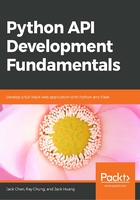
HTTP Methods and CRUD
We can easily build a RESTful API by leveraging what has already been provided by the HTTP protocol. Let's take a look at the HTTP methods that we can use to communicate with the server.
In this book, we will build a recipe sharing platform with a RESTful API as the backend. This platform will allow users to create and share their own recipes. At the same time, users will also be able to read recipes shared by other users. Using this recipe sharing platform as an example, to achieve these functionalities, we will need our API to be able to perform different actions on the recipes. We can leverage different HTTP methods here. For example, we can use the GET method to request http://localhost:5000/recipes for all the recipes. We can use the POST method to request http://localhost:5000/recipes to create a new recipe. We can also use the DELETE method to request http://localhost:5000/recipes/20 to delete a recipe with ID = 20. Please refer to the following table for details.

Figure 1.2: HTTP methods
We can see that asking the backend API to work for us is simple. We can simply use the HTTP protocol to communicate our request.
In fact, with this recipe sharing platform, you can see the majority of the actions we require will revolve around CREATE, READ, UPDATE, and DELETE. This is generally true for all other web applications as well. In the developer community, we call this CRUD in short. In a nutshell, CRUD models the life cycle of database record management.
Modeling our web applications this way can help us easily construct a functioning web system, as these actions are related to the HTTP methods. Constructing our application with this architecture is simple, powerful, and highly readable.
As you can probably imagine, we will need to send information to the backend server. For example, you may want to store a recipe in the backend database. You send the recipe over HTTP with a pre-agreed format with the backend. A pre-agreed format can be understood as a language used to communicate with the waiter/waitress in our previous metaphor. In real life, we have different languages, such as English, German, Chinese, and so on. We need to speak the right language for the other side to understand. In the web API domain, there are two prevalent standards, JSON and XML. We will mainly talk about JSON here because it is more readable and widely adopted.